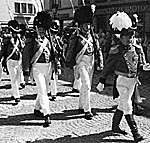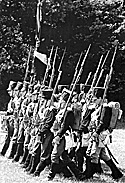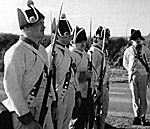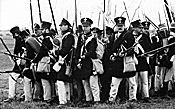A Number of Confederation states are now represented, the western ones being based around former ceremonial City Guards, of which there are many acrioss Germany and central Europe.
The BADEN FORCES 1786-1815 comprise an artillery unit of infantry and cavalry currently forming up, in co-operation with the Freiburg Burger-Ehren- Garde (City Guard).The original artillery force was raised in 1786 with a strength of 2 Officers, 2 NCO's and 32 artillerymen servicing 8 cannons. The then Margravate uniform was styled similar to the old Prussian uniforms, but later became more elaborate in the jacket cut with crested helmets as the state grew to become a Grand Duchy. The unit now comprises 6 people. The infantry unit, the Leib-Grenadiergarde was newly raised in 1803 as a single grenadier battalion, which became the Grand Duke's person guard, comprising 6 companies (20 Officers, 45 NCO's and 600 Grenadiers). The cavalry unit, Light Dragoons, numbered 6 officers, 9 NCO's, 66 troopers and 2 buglers on 1803. Both are now recruiting- contact Robert Schlenker, Kirchgasse 4, 78083 Dauchingen.
 A few miles east in Villingen is another Baden Town Guard unit, the
HISTORISCHES GRENADIER 1810 (at right), which was founded in 1955 and now
comprises about 200 people, including ordinary members, uniformed troops,
sport riflemen and ladies in local costume. The uniformed unit represents the
town guard in 1810, when the old style of recruitment based on the town
guilds was abandoned. In that year it was re-organised into cavalry, infantry,
grenadiers and a band.
A few miles east in Villingen is another Baden Town Guard unit, the
HISTORISCHES GRENADIER 1810 (at right), which was founded in 1955 and now
comprises about 200 people, including ordinary members, uniformed troops,
sport riflemen and ladies in local costume. The uniformed unit represents the
town guard in 1810, when the old style of recruitment based on the town
guilds was abandoned. In that year it was re-organised into cavalry, infantry,
grenadiers and a band.
Although the Grenadiers and Fusiliers were amalgamated in 1830, the Town Guard survived until 1849, when it was disbanded following the 1848 revolt.
 At right, Brandenburgisches Infantry Regt #8 (Liebregiment)
At right, Brandenburgisches Infantry Regt #8 (Liebregiment)
The association began as a marching formation in national costume, mainly attending parades and forming a civic ceremonail guard. Consequently their uniforms and drill were representational and lacked authenticity. The women wore the local Villingen costume, as they still do at local cultural displays, a costume similar to that worn by the upper classes of the time when the are was part of the scattered Vorderosterreich, (Austrian enclaves prior to 1803).
Having become involved in re-enactment from 1985 onwards, after meeting Neil Morrison, part of the association has been participating in European events. Their knowledge of local costume and life has also helped enhance the Living History side of such events. Similarly, much has changed in their equipment and drill with the introduction of the correct manual, flintlocks etc. Forage caps have been introduced and many women now also dress as camp followers. Besides an officer and Grenadiers, there are four drummers, an ensign and three pioneers, together with two small Rosenheimer saluting cannon.
The association is still primarily concerned with local parades, attendence at re-enactments being voluntary. Shooting competitions with old and modern weapons, preserving local customs and tradition and Living History remain important activities within the association, which holds weekly meetings on Fridays in the town. Those joining the re-enactment unit have a trial period of 6 months, during which they can borrow uniform and basic kit. Contact: Wolfgang Kunle, Hochstrasse 44, 78048 VSVillingen.
 Saxony fields three groups, the first of which covers almost the entire
Napoleonic period by representing two units as required. Originally three
enthusiasts who had been involved in the hobby for some years
formed 3 Compagnie (Koniglich Saschsisches--photo at right) 1. Regiment Leicht Infanteries
in April 1987, primarily aiming to recreate the history of Saxon troops in the
campaigns of the period in a Living History format as well as publishing
research. (5).
Saxony fields three groups, the first of which covers almost the entire
Napoleonic period by representing two units as required. Originally three
enthusiasts who had been involved in the hobby for some years
formed 3 Compagnie (Koniglich Saschsisches--photo at right) 1. Regiment Leicht Infanteries
in April 1987, primarily aiming to recreate the history of Saxon troops in the
campaigns of the period in a Living History format as well as publishing
research. (5).
As the green uniforms of the light infantry were only introduced in 1810 the unit decided in 1992 to add the earlier, rather antiquated white Line infantry uniforms to cover the period 1803-10, albeit it could also be used for the earlier revolutionary period campiagns on the Rhineland.
The unit thus also recreates the Oberst-Lieutenants-Compagnie of the Saxon "Churfurst" (Elector) (1807-9 "Konig" ) Regiment. The 10 Gemeine (privates) are divided into 2 sub-units, which are commanded by 2 Gefreits (Lance Corporarl) and Korporal (Sergeant, which was this NCO's title in the earlier period). The unit doesn't have camp followers.
The original "Elector" regiment's date of formation is not known, but it became the Leibregiment in 1670, the Churfurst in 1764 aand Konig in 1806, participating in the campaigns of 1793, 1796, 1806-07 and 1809. The 1st Light regiment was initially created by combining the rifle companies (Schutzen) from the Clemens, Low, Cerrini, Anton, Max and Friedrich Infantn regiments into the 2nd Egiby Schutzen Batallion, which became the 1st Light infantry Regiment on 1st May 1810 This unit served in the 1809, 1812, 1813-14and 1815campaigns.
Based around Leipzig this unit is particularly interested in the Spring campaign of 1813 and the Autumn campaign of 1806 as well as the battle of Leipzig itself. Contact: Jorg Ttze, Paschwitzer Landstrasse 34, 04838 Sprotta- Siedlung.
A more recent Electoral Saxon group, the FELDREGIMENT BEVILAQUA recreates an 1806-uniformed unit. Formed in October 1994 it already stands at 12 members, all of them experienced re-enactors, also based in the Leipzif area, who intend to recreate both camplife and battles of the period using extensive research into source material. This unit is also a member of the "Freundeskreis Lebensige Geschichte" (Friends of Living History }.
The original unit was formed in 1748 as the "Graf Bellegarde" Grenadier battalion but in 1750, as the "Churprinzess" Grenadiers, it was captured, along with the whole Saxon army at Pirne and disbanded.
In the following year Grenadiers who had deserted Prussian territory, along with Bavarian volunteers, formed a new grenadier battalion in Hungary and continued to fight in the Seven Years war as part of the French army. With the coming of peace in 1763 it returned to Saxon service as the "Churfurstin" Infantry regiment, but because of its history and steady performance at Pirna, its troops were allowed to carry Grenadier sabres and beat the Grenadier march, rights enjoyed until disbandment.
In 1806 the 2nd battalion of the "Bevilaqua" fought alongside the Prussians at Jena as part of Nehrhoff's Brigade in Niesemeuschel's division. Affer repelling several French attacks, the battalion was captured along with the rest of the division, when it was overrun by French Cavalry.
In the following campaign of 1807 the regiment fought alongside the French and against the Austrians in 1809 as the "Dyherrn" Infantry regiment. However the 1810 reorganisation of the Saxon army saw the regiment disapper as it was merged with three others due to the shortage of manpower.
In 1806 the unit had its base in Leipzig with recruitment districts in the city, Eilenberg and Delitsch, The Pleissenberg in Leipzig was continuously garrisoned by one of the regiment's battalions until 1809. Contact Tobias Reh, Uranusstrasse 18,04205 Leipzig.
 The third Saxon unit comes from Finsterwalde, also home of the Old
Guard Grenadiers and is likewise originally a Living History Group. The
Interessengemeinschaft "Historische Uniformen Sachsens 1813" fields the
SAXON LEIBGARDE GRENADIER REGIMENT (seen in photo at right). The association was founded
by 5 enthusiasts in 1988 under the requisite DDR Culture Ministry supervision
in Finsterwalde, but joined the NG soon after reunification.
The third Saxon unit comes from Finsterwalde, also home of the Old
Guard Grenadiers and is likewise originally a Living History Group. The
Interessengemeinschaft "Historische Uniformen Sachsens 1813" fields the
SAXON LEIBGARDE GRENADIER REGIMENT (seen in photo at right). The association was founded
by 5 enthusiasts in 1988 under the requisite DDR Culture Ministry supervision
in Finsterwalde, but joined the NG soon after reunification.
The group now stands at 16 members devoted to the period history and culture of the local area, which remained part of Saxony even after the congress of Vienna. The group's interest extend beyond the authentic recreation of Saxon uniforms and equipment to promoting interest in the Wars of Liberation, supporting the Dresden Military History Musem and the Saxon Archives to improve the utilisation of these resources. One particular project is the participation in the restoration of the Konigsstein fortress, especially a casemate artillery position around which the groups intends to put on displays as well as creating a permanent exhibition of military life. Contact Uwe Bergmann, Heinrichsruher Weg 3, 03238 Finsterwalde.
The Hessian Army is represented by the GROSSHERZOGLICHES HESSISCHEN FELDARTILLERIE-KORPS, which is based in Frankfurt. Currently comprising 9 artrillerymen in the 1809 pattern uniforms, the group was formed from members of the Hessischen Korps von 1784, which the unit is still part of. The unit, drawn mainly from the Darmstadt region, aims to promote the local military and civilian history through Living History displays and the traditions of the Darmstadt dynasty of the Grand Ducal family.
The Hesse-Darmstadt artillery Corps was founded as a single unit in 1790 by Lansgraf Ludwig X and on July 12th 1806, after HesseDarmstadt joined the Confederation and was raised to a Grand-Duchy by Napoleon, it was renamed the Grand Dical Hesse-Darmstadt Artillery Corps. Now organised, equipped and drilled along French lines it took part in all the subsequent campaigns.
As the Landgraf's artillery, the unit had fought in the major campaigns from 1790-1806 along the Rhine, Main, Lahn and Lech rivers, as well as in France, the Low Countries & Austria, where all the Hessian troops distinguished themselves. After siding with Napoleon in the Confederation Hessians fought in Silesia against Prussian and Russia and in 1809, within sight of Vienna, as well as supplying troops for the Peninsula.
Always handling civil populations correectly while fighting unrelentingly against the enemy, Hessian troops suffered badly as prisoners of the British, who had previously lost heavy casualties from the Hessian artillery.
During the retreat from Moscow, the Hesse-Darmstadt contingent was for a period designated as part of the imperial Guard and was the only contingent to return home from Russia with much of its heavy equipment and artillery intact. After Napoelon's defaet at Leipzig the entire Hessian force, except, the artillery was captured. The artillerymen managed to slip away from the French army during the night before Hanau (October 30th 1813) under cover of darkness and fog.
 At right, Landwehr (from "German Napoleonic Armies recreated in colour photographs." Windrow&Greene.)
At right, Landwehr (from "German Napoleonic Armies recreated in colour photographs." Windrow&Greene.)
Aided by peasants and the Bavarians, they crosse the Main river and arrived home. Having formally abandoned Napoleon, Hesse-Darmstadt sent its troops to fight at Lyons in 1814 and protected the local population against Austrian troops more interested in plunder. During the Hundred days the small contingent, notably its artillery, distinguished itself at Strassbourg. Contact- Dieter Schule, Alt Griesheim 34, 65933 Frankfurt.
Not actually part of the Confederation, the north German city-states of the Hanseatic league maintained City Guards. Following the absorbtion of some cities into Metropolitan France in 1810 some citizens were put into French uniforms for the march to Moscow. A group in Hamburg, DARSTELLUNGSGRUPPE HANSEATISCHE LEGION represents the artillery of the legion. The original formation was composed of volunteers and was partly stationed in the Hamburg area, where the local population actively contributed to its equipment and crew
Currently a 5 man artillery crew, wearing the second uniform worn by the Legion, services a 9-par artillery piece, drilled according to the Prussian regulations. It is known that a Legion manual existed but no copy has been located (they would be delighted to hear from anyone who has a one).
The group also participates in events at Domitz fortress and is keen to research the whole subject of the Legion, its activities in northern Germany and the local civilian population with the general aim of publicising the hobby in the area. Shooting competitions are also organised as well as social activities. Contact Ulf Kretschmann, Sanderstrasse 3A, 20129 Hamburg.
(To conclude next issue with the Prussian & British units)
NOTES
1 ) this is actually a working title for a book by Peter Hofchroer, which won't be appear-
ing for a while yet!
2) See for example, the report on Leipzig '93 in AoN 13, pp 9-11
3) The regular "Circulaire" is produced three times a year by the NG and the Freundeskreis Lebendige Geschichte. costing non-members DM 4.50 each. More information from Herr Alafred Umbey, President of the NG c/o Hanseatische Auktionhaus,
Ratzeburger STr 54,D-23843 Bad Oldesloe, Germany
4) Obtainable from: Thomas Posenanski, Engerstrasse 197/5/3/12 A-1020 Venna. Austria
5) One of the unit's founders, Jorge Ttze, has written an article on the
Electoral Saxon Artillery 1793-4 which will appear in a future AoN.
More Waterloo
Back to Age of Napoleon No. 22 Table of Contents
Back to Age of Napoleon List of Issues
Back to MagWeb Master List of Magazines
© Copyright 1996 by Partizan Press.
This article appears in MagWeb (Magazine Web) on the Internet World Wide Web.
Other military history articles and gaming articles are available at http://www.magweb.com